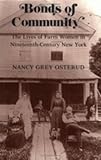Bonds of Community : The Lives of Farm Women in Nineteenth-Century New York / Nancy Grey Osterud.
Material type: TextPublisher: Ithaca, NY : Cornell University Press, [2018]Copyright date: ©1991Description: 1 online resource (320 p.) : 20 halftonesContent type:
TextPublisher: Ithaca, NY : Cornell University Press, [2018]Copyright date: ©1991Description: 1 online resource (320 p.) : 20 halftonesContent type: - 9781501729287
- 305.4 20
- HQ1438.N57 O88 1991
- online - DeGruyter
| Item type | Current library | Call number | URL | Status | Notes | Barcode | |
|---|---|---|---|---|---|---|---|
 eBook
eBook
|
Biblioteca "Angelicum" Pont. Univ. S.Tommaso d'Aquino Nuvola online | online - DeGruyter (Browse shelf(Opens below)) | Online access | Not for loan (Accesso limitato) | Accesso per gli utenti autorizzati / Access for authorized users | (dgr)9781501729287 |
Frontmatter -- Contents -- Acknowledgments -- Introduction: No Separate Spheres -- Part 1. The Rural Community -- 1. The Nanticoke Valley -- 2. The Power of Kinship -- Part II. Rural Women s Lives -- 3. Courtship -- 4. Childbearing -- 5. Women without Husbands -- Part III. Womens Work on Family Farms -- 6. The Gender Division of Labor -- 7. Work Relationships between Women and Men -- 8. Work Relationships among Women -- 9. Valuing Women's Work -- Part IV. Patterns of Sociability -- 10. Visiting with Folks and Friends -- 11. Community Organizations -- 12. Conclusion: Mutuality as an Empowerment Strategy -- Selected Bibliography -- Index
restricted access online access with authorization star
http://purl.org/coar/access_right/c_16ec
Women held a central place in long-settled rural communities like the Nanticoke Valley in upstate New York during the late nineteenth century. Their lives were limited by the bonds of kinship and labor, but farm women found strength in these bonds as well. Although they lacked control over land and were second-class citizens, these rural women did not occupy a "separate sphere." Individually and collectively, they responded to inequality by actively enlarging the dimensions of sharing in their relationships with men.Nancy Grey Osterud uses a rich store of diaries, letters, and other first-person documents, in addition to public and organizational records, to reconstruct the everyday lives of ordinary women of the past. Exploring large questions within the confines of a single community, she analyzes the ways in which notions of gender structured women's interactions with their families and neighbors, their place in the farm family economy, and their participation in organized community activities.Rare turn-of-the-century photographs of the rural landscape, formal and informal family portraits, and scenes of daily life and labor add a special dimension to Bonds of Community. It should find a ready audience among women's historians, labor historians, rural historians, and historians of New York State.
Mode of access: Internet via World Wide Web.
In English.
Description based on online resource; title from PDF title page (publisher's Web site, viewed 26. Apr 2024)


